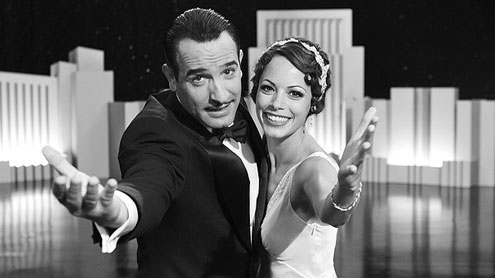 If we are to believe the movies, love and a dependable best friend are all we need to keep going. Of course, it’s all so much more complex than that. But it seems to be no coincidence that dozens of movies each year focus on love and/or buddies.
If we are to believe the movies, love and a dependable best friend are all we need to keep going. Of course, it’s all so much more complex than that. But it seems to be no coincidence that dozens of movies each year focus on love and/or buddies.
In the case of silent film star George Valentin, that buddy happens to be a Jack Russell terrier. This shouldn’t be a surprise, since dogs are said to be man’s ultimate buddy. What might be a surprise is how extraordinary “The Artist” is, despite sounding perfectly ordinary.
There aren’t an abundance of movies made in black-and-white today. There aren’t any silent films made today – certainly not ones that have a theatrical run for a paying audience. But “The Artist” changes that, and does so in an incredibly entertaining way.
“The Artist” traces the last years of silent film and the rise of the “talkies.” The main character, George Valentin (Jean Dujardin), is one of the biggest movie stars of the silent era. Meanwhile, Peppy Miller (Bérénice Bejo) is one of Valentin’s biggest fans, who would love nothing more than to break into the movies. Without giving away too much, George struggles with the transition from silent film to the sound era, while Peppy sees the transition as an opportunity.
“The Artist” is the perfect movie for a film purist. It is a movie about the movie industry. It is a movie that communicates visually, and visuals are the defining characteristic of the motion picture form. “The Artist” was shot in the common camera aspect ratio of the time in which it is set, 1.33:1. Also, while “The Artist” is basically silent, it cleverly makes use of sound on two instances. In one scene, George has a drunken vision where he sees a miniaturized version of himself – a visual treat, and funny, too.
One reason “The Artist” works so well is the chemistry between director Michel Hazanavicius, his wife and actress Bérénice Bejo, and lead actor Jean Dujardin. This is the third collaboration between Hazanavicius and Dujardin, and Bejo was in a previous film with both. The previous collaboration between the three was “OSS 117: Cairo, Nest of Spies,” which was also a tribute (and spoof). It took a look at spy movies from the 1960s. “The Artist” also works because the characters are compelling, a testament to the acting and directing.
One scene in “The Artist” literally takes the viewer through multiple takes of the same scene but manages to be entertaining. Dujardin is able to elicit humor simply from exaggerated facial expressions. Bejo is smart with subtly conveying actions through nonverbals. She bites her lip to show the nervousness of her character. In addition to being skilled with facial expressions, Dujardin and Bejo are skilled with movement. They exchange dance moves and show their potential for a certain popular television show if their film careers should somehow wash up.
“The Artist” brilliantly uses “Love Scene” from Bernard Herrmann’s score of the movie “Vertigo.” It works perfectly because one of the movie’s main characters has a strange obsession with another main character, similar to “Vertigo.”
“The Artist” is one of the best movies released in 2011. It is a loving tribute to a critical time in cinema history, when movies shifted from silent to sound. It’s interesting that it would be released now, a time when cinema is undergoing another shift, from polyester film to digital.
Reviewer’s Rating: 4 stars out of 4
Run Time: 100 minutes
Rating: PG-13
Bottom Line: “The Artist” is a must-see movie that uses techniques from the past to tell a part of the film industry’s history.









